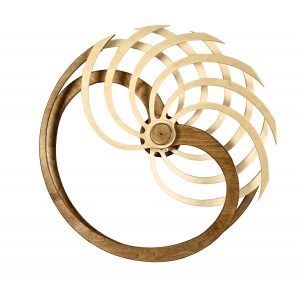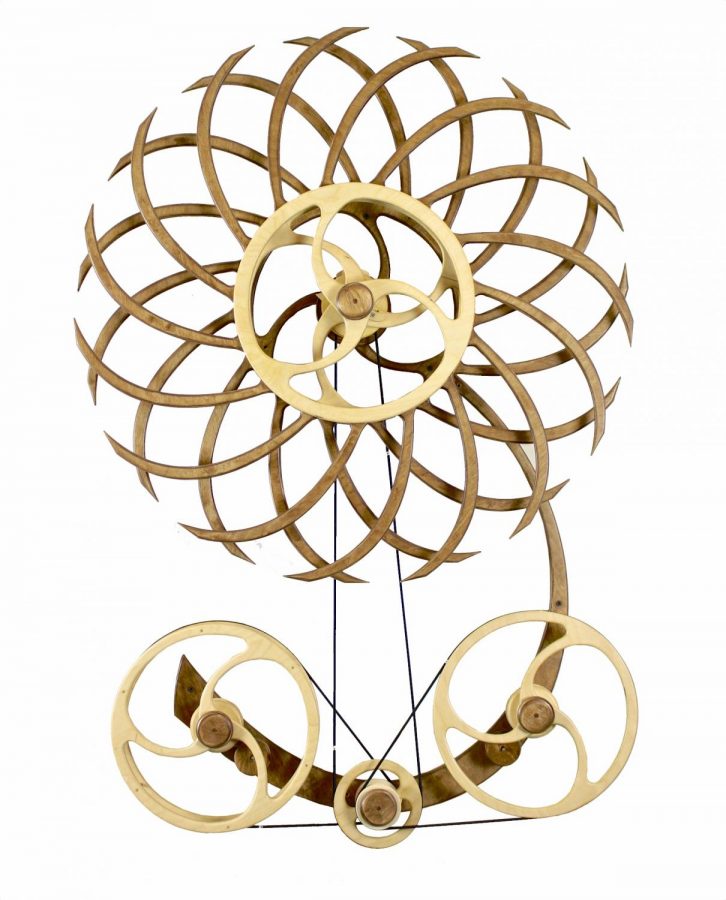David Roy’s Amazing Kinetic Sculptures
Wooden Kinetic Sculptures: Calming And Chaotic
Marjiroy. (2015). Dimensions is a spring-driven kinetic sculpture designed by David C. Roy in 2015. It is an example of his using motion to create optical patterns. A three-dimensional torus appears in the patterning wheels when the correct directions and speeds are achieved by the escapement. Retrieved from https://commons.wikimedia.org/wiki/File:Dimensions_Kinetic_Sculpture_by_David_C._Roy_2015.jpg
David Roy is a kinetic sculptor who wants people to be amazed at his calming and amusing kinetic sculptures and to figure out how they work. Roy has been working on his sculptures for about 40 years. Some of his mesmerizing sculptures create tension while others are just simply mesmerizing.
Roy’s sculptures do not require motors or electronics. Instead, they work by:
- Having an energy source such as a force spring
- Controlled by an escaping mechanism
- The mechanisms are locked
- When it is unlocked, it releases a bit of energy, which then moves a second device
- That retriggers the escapement.
- That releases a bit more energy and restarts the cycle
The sculptures are not perpetual. They need to be rewound every once in a while, like a wind up toy.
Now, you are probably wondering how Roy makes the incredible designs. The designs are made by Roy thinking and daydreaming of the designs in his head. Next, he sketches out his ideas on a computer, on a program called Illustrator. Then, he animates his designs in Adobe After Effects. Animating before building the sculpture lets Roy see what the optical pattern will look like. Roy also uses a program called Working Model. Roy uses it to calculate the center of mass of the arrangements and the separate parts of the sculpture. It is important so that the balance is right and the sculpture moves in the way Roy wants it to move. Except, Working Model does not exist for Mac anymore. So Roy uses old iBooks for the program. Roy then tinkers around in the programs until he is satisfied with the designs. Then Roy sends his designs in a file to a Woodworker who cuts some of the pieces on a CNC machine.
The rest of the pieces are done by hand. The basic tools Roy uses are drill press, bandsaw, and sanders. He does also use the typical hand tools such as hammer and screwdriver. Roy uses these tools to make pulleys and levers and to smooth off the larger, machine cut pieces. Once all of the pieces are built, cut, and stained, Roy then assembles the sculpture and tests them. All the big wooden parts have to be equally balanced for the sculptures. Roy uses very small brass weights that he attaches to the back of the sculpture to get things to balance.
Roy says that he probably spends most time in the assembly phase of his sculptures. But the testing is also important. Roy has a big wall that he uses to test the sculptures. He puts his sculptures on the wall and leaves them running for a long time. He tests them to see if they work and if there are any bugs before a customer gets it. Roy stares at his sculptures while they’re moving for a long time until he gets the “real feel” for the sculpture. Then, there is one more step.
The hardest thing for Roy to work on with his sculptures is the artistry. Roy’s wife, Margie, who was a sculpture major at Rhode Island School of Design, helps and tutors Roy with the artistry of his creations. Margie is also the person who sparked Roy’s interest in kinetic sculptures.
Roy and Margie’s small wooden kinetic sculpture hobby was soon a full business. This business did not exactly start intentionally. Roy says that they didn’t know the hobby would grow so fast and that they had at first made it because they could and they were just playing.
Roy’s continued passion for making his sculptures is because of one thing: Solving the problems of his sculptures. Roy’s first sculptures were noisy and annoying. So he problem-solved and created a mechanism that was quiet. The sculpture was called Anticipation. Another challenge that Roy enjoys has been making longer run times. It took a couple years for Roy to get his creations up to an hour. The way Roy is making his sculptures have longer run times has been slow-motion, which works but is not as entertaining. Back in early 2020, Roy was interested in making his sculptures have chaotic motion. His chaotic motion sculptures are sculptures that change at unpredictable intervals. Roy made his first chaotic sculpture a couple years ago. The sculpture was simply named “Chaos”. One big part of designing is naming. Roy has a list of possible names that he and his wife look at once a sculpture is done being built and tested. Roy says that naming is difficult, and it can be; however, it is an important part of his work.
Some of Roy’s sculptures have been hard for him to make. Some have taken at least a year to make, and others he’s put aside to work on again later. Roy says that some of them have come out right and others have come out boring. “The frustration is kind of nice to have ‘cause it makes the joy after better”, Roy says. Roy’s passion for his creations isn’t slowing down soon. Roy likes to solve the problems of his sculptures.

Related Stories
https://www.woodthatworks.com/kinetic-sculptures











